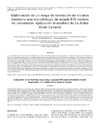Identificador persistente para citar o vincular este elemento:
https://accedacris.ulpgc.es/handle/10553/3015
| Campo DC | Valor | idioma |
|---|---|---|
| dc.contributor.author | Bejarano, C. | en_US |
| dc.contributor.author | Cabrera, M.C. | en_US |
| dc.contributor.author | Candela, Lucila | en_US |
| dc.contributor.author | de Paz, J.M. | en_US |
| dc.date.accessioned | 2010-02-11T02:31:00Z | |
| dc.date.accessioned | 2018-03-02T09:36:29Z | - |
| dc.date.available | 2018-03-02T09:36:29Z | - |
| dc.date.issued | 2003 | en_US |
| dc.identifier.uri | https://accedacris.ulpgc.es/handle/10553/3015 | - |
| dc.description.abstract | La contaminación difusa por nitrato constituye una de las mayores amenazas actuales para la calidad de las aguas subterráneas. De\nhecho, varias directivas europeas, nacionales y regionales se han legislado con el fin de minimizar el efecto de las prácticas agrarias en\nla contaminación de los acuíferos por nitratos. El acuífero de La Aldea (Gran Canaria, España) se ha declarado como vulnerable a la contaminación\npor nitrato según dichas normas. En este estudio se presenta una metodología para desarrollar el acople de un sistema de\ninformación geográfica-SIG con el modelo de simulación de nitrato GLEAMS. Esta herramienta permite calcular la cantidad de nitrato lixiviado\nprocedente de los cultivos de tomate bajo invernadero y da la oportunidad de simular otros rangos de fertilización para minimizar\nel riesgo de contaminación de las aguas subterráneas. Se comprueba que la pérdida de nitrato por lixiviación en la zona a partir de dichos\ncultivos podía llegar a los 500 kg N/ha, casi un 62% del aportado como fertilizante mineral en un manejo tradicional. Por ello, se aconseja\nla aplicación de las recomendaciones de abonado incluidas en el código de buenas prácticas agrarias de Canarias o cualquier otro sistema\nde recomendación de abonado mineral para reducir estas pérdidas, minimizando de esta forma el riesgo de contaminación de las\naguas subterráneas. ABSTRACT: Nitrate diffuse pollution is one of the main risks that affect the groundwater quality. Several european directives, national and regional\nguidelines have been enacted to protect the aquifers against the effect of the agricultural management practices. The “La Aldea” aquifer\nwas declared nitrate vulnerable area following these laws. In this study a methodology was developed to link a Geographical Information\nSystem (GIS) with a nitrogen simulation model (GLEAMS) in this area. This tool allows to assess the amount of nitrate leaching that\ncoming from the traditional nitrogen fertilization rates in greenhouses tomato crops, and gives the opportunity to simulate other fertilization\nrates to reduce the risk of groundwater pollution. The nitrate leaching reached to 500 kg N/ha in several zones of the study area, that\nrepresent the 62% of the nitrogen fertiliser apply in a traditional management. It was recommended the application of the Code of Good\nManagement Practices or other recommendation system to decrease the nitrate leaching, in order to reduce the risk of groundwater pollution. | en_US |
| dc.language | spa | en_US |
| dc.relation.ispartof | Boletín Geológico y Minero | en_US |
| dc.source | Boletín Geológico y Minero ISSN 0366-0176], v. 114 (2), p. 213-224 | en_US |
| dc.subject | 250605 Hidrogeología | en_US |
| dc.subject.other | Contaminación difusa | en_US |
| dc.subject.other | Modelo GLEAMS | en_US |
| dc.subject.other | Gran Canaria | en_US |
| dc.subject.other | Nitratos | en_US |
| dc.subject.other | Sistema de Información Geográfica (SIG) | en_US |
| dc.subject.other | Zona no saturada | en_US |
| dc.subject.other | Geographic Information System (GIS) | en_US |
| dc.subject.other | Non-point source pollutants | en_US |
| dc.subject.other | Model GLEAMS | en_US |
| dc.subject.other | Nitrate | en_US |
| dc.subject.other | Vadose zone | en_US |
| dc.title | Elaboración de un mapa de lixiviación de nitratos mediante una metodología de acople SIG-modelo de simulación : aplicación al acuífero de La Aldea (Gran Canaria) | en_US |
| dc.title.alternative | Elaboration of an-leaching map using a coupled GIS-based simulation model. | en_US |
| dc.type | info:eu-repo/semantics/article | en_US |
| dc.type | info:eu-repo/semantics/article | en_US |
| dc.type | Article | en_US |
| dc.identifier.absysnet | 313574 | - |
| dc.identifier.crisid | -;2328;-;- | |
| dc.description.lastpage | 224 | en_US |
| dc.description.firstpage | 213 | en_US |
| dc.relation.volume | 114 | en_US |
| dc.investigacion | Ciencias | en_US |
| dc.type2 | Artículo | en_US |
| dc.description.numberofpages | 10 | en_US |
| dc.utils.revision | Sí | en_US |
| dc.identifier.supplement | -;2328;-;- | - |
| dc.identifier.supplement | -;2328;-;- | - |
| dc.identifier.ulpgc | Sí | en_US |
| dc.contributor.buulpgc | BU-BAS | en_US |
| dc.description.esci | ESCI | |
| item.fulltext | Con texto completo | - |
| item.grantfulltext | open | - |
| crisitem.author.dept | GIR IUNAT: Geología de Terrenos Volcánicos | - |
| crisitem.author.dept | IU de Estudios Ambientales y Recursos Naturales | - |
| crisitem.author.dept | Departamento de Física | - |
| crisitem.author.orcid | 0000-0002-4556-4665 | - |
| crisitem.author.parentorg | IU de Estudios Ambientales y Recursos Naturales | - |
| crisitem.author.fullName | Cabrera Santana, María Del Carmen | - |
| Colección: | Artículos | |
Visitas
253
actualizado el 12-oct-2024
Descargas
129
actualizado el 12-oct-2024
Google ScholarTM
Verifica
Comparte
Exporta metadatos
Este elemento está sujeto a una licencia Licencia Creative Commons

